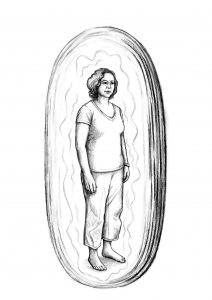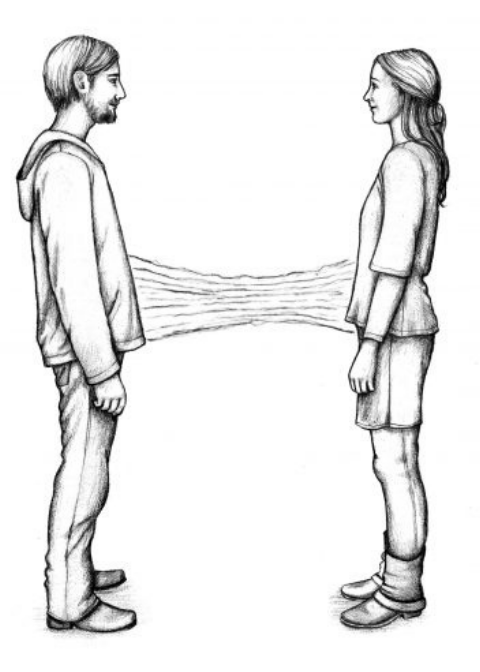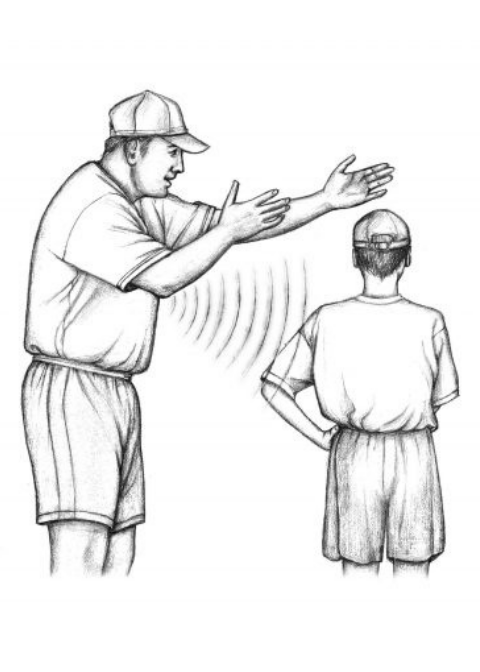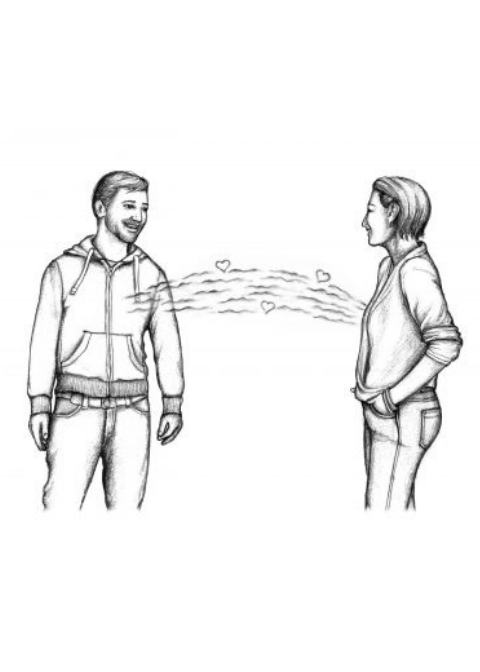Taking In GOOD ENERGIES
(Adapted from “Your Energy in Action! Energy Balancing in Daily Life)
Vulnerability
An American working as a contractor for the US military in Afghanistan was coming for a vacation here at our retreat center. Before he came we imagined him as a tough-looking military guy, but when we met him he was a man in his late forties who looked like the typical “guy next door”.
He told us about his work there in Afghanistan and what it was like for him personally. He was friendly but underneath we could feel his tension and a wall of protection. He confirmed this when he said; “I’m always on alert. I can never relax there. I always have the feeling I am in an enemy environment. Even though I am in a walled military compound, supposedly protected and safe, I can never sleep at peace. I sleep with my clothes on, because an attack could come at any moment.”
Being here in a safe and friendly environment, and having a loving time with his wife, he was able to relax. After a few days his face started to change. A metamorphosis happened.
Towards the end of his stay we were surprised when he said he was eager to go back. “If I stay here any longer I’ll never be able to handle being back there. I’d rather relax only a bit so I can toughen up easily again.” His wife commented, half-jokingly and half-serious, that he can only take a safe and loving space for a short time before it gets too dangerous!

Walls protecting vulnerability
What we saw was that both were true. He needed to protect himself in Afghanistan by putting on a protective shield. Being here was so good for him to relax those walls, but he felt if he relaxed too much he would be too vulnerable upon arriving back there.
His wife’s comment was astute; letting his walls down and letting himself be touched was both wonderful and overwhelming to him. He could only take it in small doses before the vulnerability became too much and his defenses wanted to reassert themselves. Her comment indicated that even without him being in a war zone, his pattern was to only let his defenses down for a short time before he would find an excuse to put them up again.
This man showed us a core truth about human nature – that we are all vulnerable. No matter how tough, strong or “above it all” one appears on the surface, underneath everyone is vulnerable. We are touched by everything around us.
Our fundamental nature is vulnerable; we can be touched by life. To protect ourselves we build walls within our energy body that protect us.
Every Human Being is Vulnerable
Definition: Vulnerability
Vulnerability is our fundamental fragility, that capacity that makes us touchable and affected by a myriad of things
This is one of the most important insights that arise through understanding energy; that every human being is vulnerable. The term ‘vulnerable’ as we’re using it here means touchable – we can be touched; things move us. It recognizes a central truth about the human energy system; that our energy body is fragile and affected by a myriad of things.
This man also demonstrated some of the ways we protect our vulnerability and how some of these are healthy and some not. His actions reflect one of the greatest dilemmas this core vulnerability poses for every human being.

How much can we be open?
Can we reveal our vulnerability?
With whom and when?
How do we protect our vulnerability?
How can we let our protections down after they’ve gone up?
Can we be over-protected?
The answers to these questions vary greatly by person and situation, but basically, with some notable exceptions, most of us have built protective walls within our energy field to survive. Some of these walls we take down when we feel safe; perhaps with our spouse or kids, a good friend, or maybe alone in nature. But many of these walls have become almost permanent protective layers within our energy body. Only on rare occasions do these walls come down, to then go quickly up again.
Definition: Walls
Walls are protective layers of energy within the human energy field
Conscious Vulnerability and Conscious Boundaries
Two of the most important skills you can learn through energy work are conscious vulnerability and conscious boundaries. Conscious vulnerability is the ability to drop our walls and let our selves be touched. A conscious boundary is the ability to put up a protective wall and not let things come in that shouldn’t.
Definition: Conscious Vulnerability
Conscious vulnerability is the ability to drop our walls and let our selves be touched.Definition: Conscious Boundary
A conscious boundary is the ability to put up a healthy protective wall and not let things come in that shouldn’t.
This is important for several reasons:
1. There are things we want to be touched by. They are like energy food for our being, nurturing and enriching us. These are things like love, care, respect, as well as energies from nature, animals, etc.
2. There are energies that we don’t want to come in because they are not healthy for us, things like aggression, negativity, judgment and disturbed emotions. We need to be able to “put on an energetic rain coat” at the right moments.
3. We can’t experience intimacy if we are behind a wall. Two knights in armor can’t get very close. Intimacy occurs when we take off our armor, open and let someone in.
4. Lastly, to be vulnerable is to be touched by life. A life lived behind walls is a very partial life. A life lived open means you are participating in the richness of That Which Is.
Taking the Good Stuff IN
Energies are coming towards us all the time. And when we say all the time we mean ALL THE TIME! Every second of every day an unbelievable amount of energy is headed our direction.
These energies enter our energy field, to then affect us in a myriad of ways. Some of these energies are good for us, providing “energetic sustenance” in the form of vitality or enriched feelings. Some of the energies are neutral; passing through our fields with no effect. And some of the energies are unhealthy, creating imbalance or disturbance.
One of the primary skills in Energy Balancing is discerning which energies are positive, which are neutral and which are negative. A second skill is to take in those that are healthy and to not take in those that aren’t.
Energies to Let In
 It’s Monday morning. You’d rather be anywhere else, but here you are, walking into your work. A co-worker with whom you have a good relationship greets you with a simple, “Good morning”. You grunt a good morning in return and continue on to your desk.
It’s Monday morning. You’d rather be anywhere else, but here you are, walking into your work. A co-worker with whom you have a good relationship greets you with a simple, “Good morning”. You grunt a good morning in return and continue on to your desk.
You just missed.
One of the primary skills in Energy Balancing is to take in the “good stuff” when the good stuff is there. Your co-worker just gave you some good stuff. Granted, not everyone saying good morning is sending good energy. They may be just going through a social ritual without anything behind it. But lets for a moment assume that this co-worker actually meant it; they were happy to see you and their heart had an upwelling of warmth and good will.
When someone cares they send us a stream of positive energy
When someone cares they send us a stream of positive energy. Those simple words, “Good morning”, are more than words; there’s also an energy transmission of care, respect and even love.
Love is energy. Care is energy. Respect is energy. These are all energetic substances vibrating at particular frequencies. They are substances a person sends out that then enters your energy field.



 The difference in the type of thought or feeling is the difference in vibration. Some energies vibrate in the frequency we call emotion, some at the frequency we call thought. Some vibrate at very high frequencies we call inspiration, genius or enlightenment. Others vibrate at frequencies we call sadness or anger. Some thoughts and emotions are so-called negative because their vibrations are destructive and harmful to us. Others are deemed positive because their vibrations are life supportive and uplifting. All are substance at various levels of vibration.
The difference in the type of thought or feeling is the difference in vibration. Some energies vibrate in the frequency we call emotion, some at the frequency we call thought. Some vibrate at very high frequencies we call inspiration, genius or enlightenment. Others vibrate at frequencies we call sadness or anger. Some thoughts and emotions are so-called negative because their vibrations are destructive and harmful to us. Others are deemed positive because their vibrations are life supportive and uplifting. All are substance at various levels of vibration.
I can’t say this enough – energy is substance. This understanding is a magic key that can unlock an incredible new state of fulfilled living. It means that every thought and feeling is a form of energy and that this energy gets transmitted from one person to another and accumulates in rooms, places and in physical objects.
Some of this substance is energies you need. For example, imagine going through the day without any social contact. Now maybe you’d be in delight if the rest of your day were like that. That probably means then that you are over-saturated with too many energies or the energies around you are one’s you don’t want. If this is the case, then imagine a week, a month or a year with not one person saying anything to you. A point would come where it’s just too long to go without.
That’s because we all need positive energy from other people. We need warmth, respect and love. These come in different ways: It can be warm energy from the belly, respect energy from the solar plexus, or love energy from the heart, as well as many other energies coming from other energy centers.
When your co-worker greeted you, they were sending a stream of positive energy towards you. Assuming for a moment that their energy is “clean” (I’ll address another time clean and unclean energies), this is an energy you would want to take in.
What do we mean by take in? Let’s use another example to highlight this. Someone you know compliments you. You can substitute your own words for our words here but imagine they say something like, “I really respect what you did back there. That was very loving and generous.”
As part of an exercise in our trainings we ask a person to come to the front of the room. Members of the audience then say positive things to them. It’s amazing the various colors of red that the human face can exhibit! You see people twisting and turning, hemming and hawing, and in general looking like they’re being slowly tortured. Invariably we hear the words, “Yes, but…” as they deflect what’s coming towards them. It’s as if we just can’t hear it when someone says something nice about us.
Exercise: An Experiment for Today
We’d like to suggest an experiment for you to make today with people you interact with – it can be your partner or kids, a co-worker, or a clerk at the store. Say something positive about them to them. It need not be anything too sophisticated. It can be as simple as, “You look very nice today.”, or, “I find you very skilled in how you did that.”
Then watch what happens.
How many people really take in the energy?
How many deflect it?
How many contradict you with a negative, perhaps saying something like, “Well, I’m not really very good at this. It just looks that way.”
